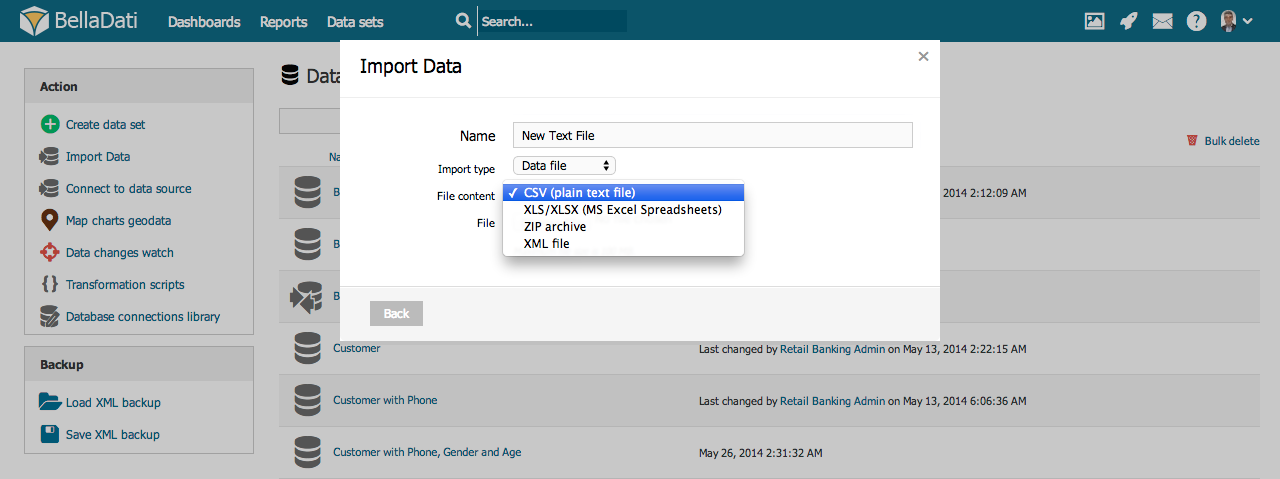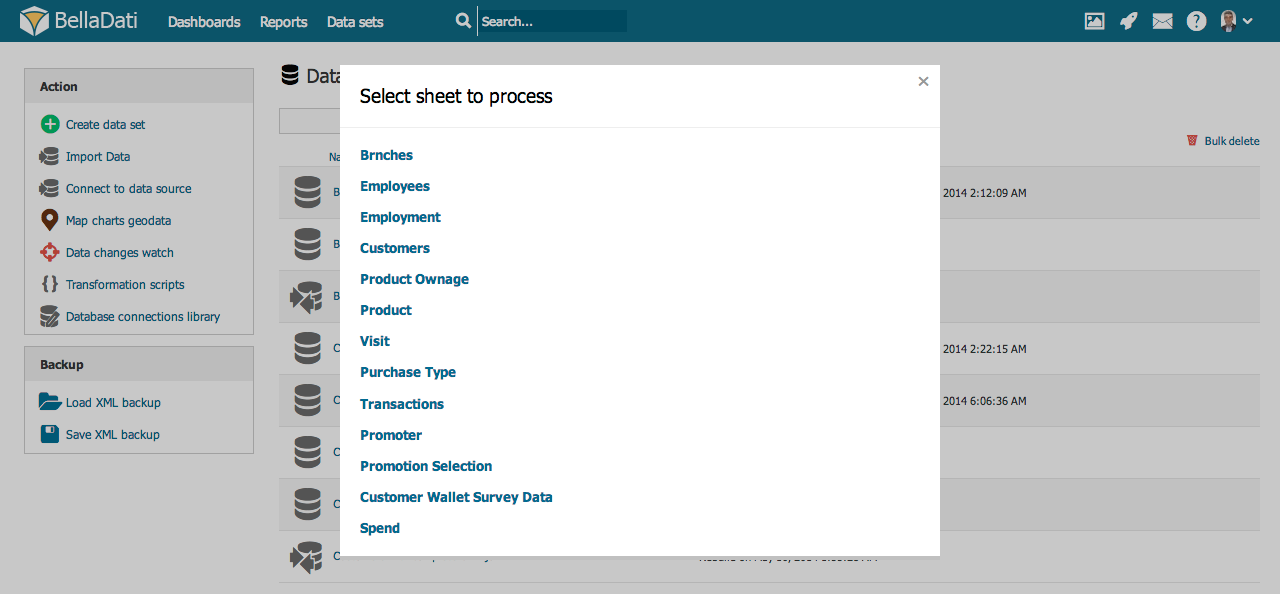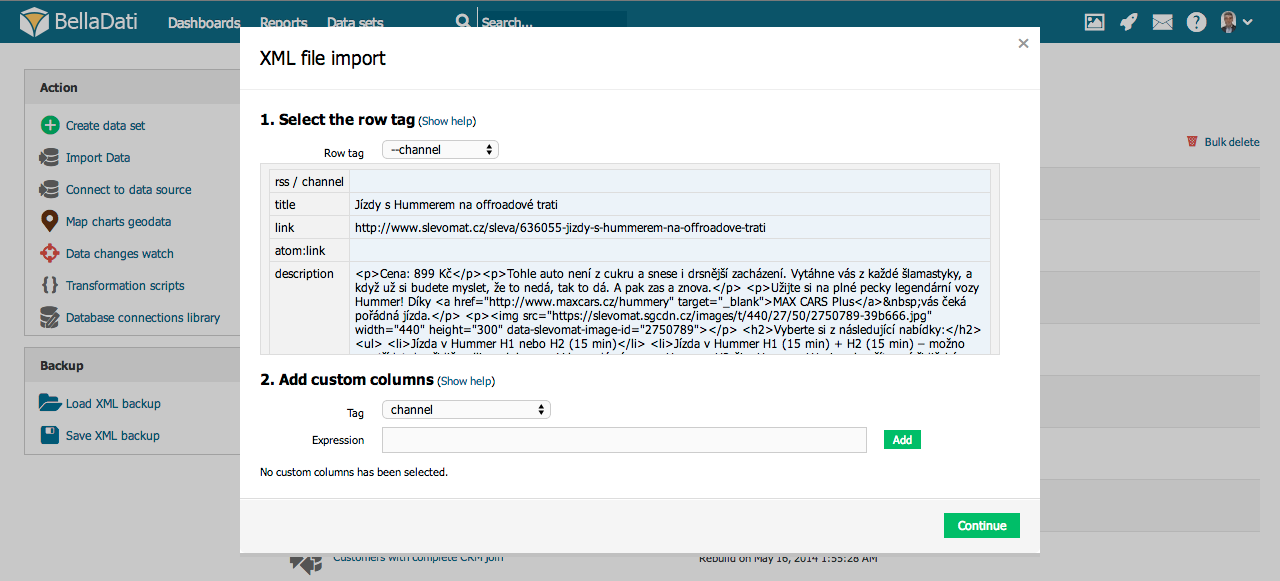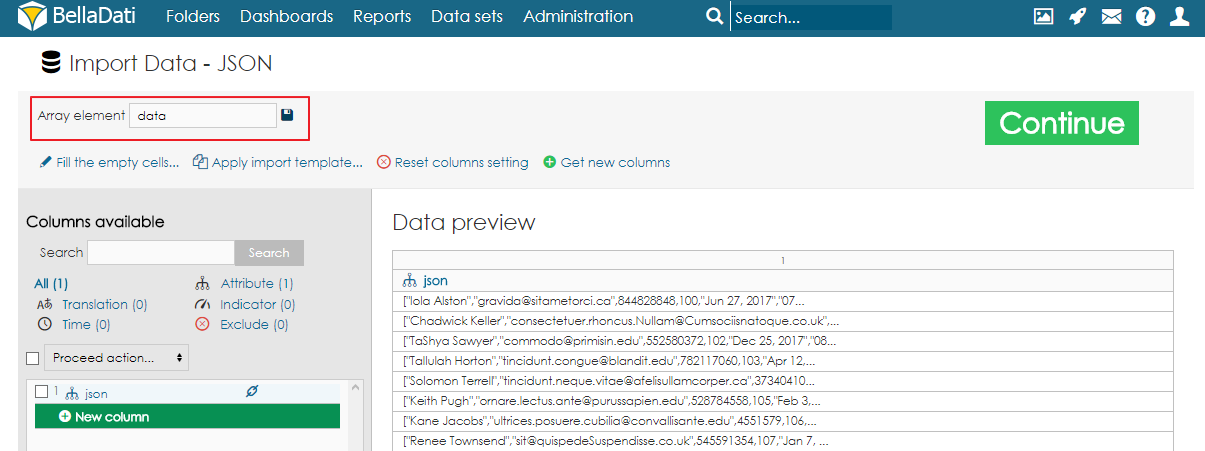Page History
| Sv translation | ||||||||||||||||||||||||||||||||||||||||||||||||||||||||||||
|---|---|---|---|---|---|---|---|---|---|---|---|---|---|---|---|---|---|---|---|---|---|---|---|---|---|---|---|---|---|---|---|---|---|---|---|---|---|---|---|---|---|---|---|---|---|---|---|---|---|---|---|---|---|---|---|---|---|---|---|---|
| ||||||||||||||||||||||||||||||||||||||||||||||||||||||||||||
The following file formats are supported for manual import in BellaDati:
To import file:
Importing from CSVWhen you are importing from CSV, please continue directly to Import settings page.
Importing from Microsoft ExcelAfter uploading XLS/XLSX file you will be prompted to select the desired spreadsheet list.
Importing from XMLIn the XML importing guide, you will be prompted to select the row tag, which represents repeatable data sentence. The following example illustrates it on XML file containing employees:
In this case, the row tag is
Importing from ZIPImporting data compressed as ZIP archive represents an effective way how to reduce imported file size and also upload times significantly. It can contain the following file formats:
Please follow corresponding chapters above to continue importing Microsoft Excel or XML file formats.
Importing From JSON
BellaDati also allows users to import data from JSON file. By using special transformation functions, it is possible to parse JSON arrays and objects. In some cases, it might be necessary to change Array element to correctly parse the data into rows. This can be done in the import settings. After choosing the Array element correctly, it is possible to use the function parseJSON() to load the JSON value into a variable and then access the values by using functions getString(), getInteger(), getDouble(), etc. to load the values. To access a nested object, users have to use function getJSONObject(). To access an array, function getJSONArray() is available.
ExamplesLet's have a JSON file with following structure:
To be able to get the values, users need to specify sales as Array element. To get the category, add a new column as an attribute and use following code:
To get the total items, add a new column as an indicator and use following code:
To calculate the total price from all the item prices, use this formula:
Let's have this JSON:
To access value from the JSONArray, use this formula:
Let's have this JSON:
In this case, we need to set "data,data" as the Array element. In order to get the value from the element name, we can use the following transformation script:
Next Steps |
| Sv translation | ||||||||||||
|---|---|---|---|---|---|---|---|---|---|---|---|---|
| ||||||||||||
BellaDati, pri manuálnom importe, podporuje nasledujúce formáty súborov:
Ako importovať súbor:
Import z CSVAk importujete zo súboru CSV, pokračujte priamo na stránku Nastavenie importu Import z Microsoft ExcelPo nahraní XLS/XLSX súboru je potrebné vybrať, z ktorého listu chcete dáta importovať.
Import z XMLPri importe z XML od Vás bude aplikácia žiadať výber elementu určujúceho začiatok nového záznamu (tag). Nasledujúci obrázok obsahuje ukážku takéhoto elementu v XML súbore obsahujúcom zamestnancov:
V tomto prípade je elementom
Import zo ZIPImport dát z archívu ZIP umožnuje jednoduchoe znížit veľkosť importovaného súboru ako aj čas importu. Môže obsahovať nasledujúce formáty:
Na následný importov zo súborov XLS/XLSX a XML postupujte podľa návodu vyššie.
Kam ďalej |
| Sv translation | ||||||||||||||||||||||||||||||||||||||||||||||||||||||||
|---|---|---|---|---|---|---|---|---|---|---|---|---|---|---|---|---|---|---|---|---|---|---|---|---|---|---|---|---|---|---|---|---|---|---|---|---|---|---|---|---|---|---|---|---|---|---|---|---|---|---|---|---|---|---|---|---|
| ||||||||||||||||||||||||||||||||||||||||||||||||||||||||
以下のファイル形式は、BellaDatiの手動インポートでサポートされています:
ファイルをインポートするには:
CSVからインポートCSVからインポートする場合は、Import Settingsページへ直接進んでください。 Microsoft ExcelからインポートXLS/XLSXファイルをアップロード後、目的のスプレッドシートリストを選択するよう求められます。
XMLからインポートXMLインポートガイドでは、繰り返し可能なデータ文を示す行タグを選択するよう求められます。以下の例は、従業員を含むXMLファイルで行タグを示しています:
この場合、行タグは<employee>です。
ZIPからインポートZIPアーカイブとして圧縮されたデータをインポートすることは、インポートされたファイルサイズとアップロード時間を劇的に減らす効率的な方法を表します。以下のファイル形式を含めることができます:
Microsoft ExcelまたはXMLファイル形式のインポートを続けるには、上記の対応する章をご参照ください。
JSONからインポート
BellaDatiでは、ユーザーがJSONファイルからデータをインポートすることもできます。特別な変換関数を使用することにより、JSON配列とオブジェクトを解析できます。 場合によっては、データを行に正しく解析するために配列要素を変更する必要があります。これは、インポート設定で行うことができます。 配列要素を正しく選択した後、parseJSON()関数を使用してJSON値を変数にロードし、getString(), getInteger(), getDouble()といった関数を使用して値をロードし、値にアクセスすることができます。ネストされたオブジェクトにアクセスするには、getJSONObject()関数を使用する必要があります。配列にアクセスするには、関数getJSONArray()関数を使用できます。
例次の構造を持つJSONファイルを作成しましょう:
値を取得できるようにするには、配列要素としてsalesを指定する必要があります。 カテゴリーを取得するには、属性として新しい列を追加し、次のコードを使用します:
合計アイテムを取得するには、インジケータとして新しい列を追加し、次のコードを使用します:
すべてのアイテムの価格から合計価格を計算するには、次の式を使用します:
このJSONを使用してみましょう:
JSONArrayから値にアクセスするには、次の式を使用します:
このJSONを使用してみましょう:
この場合、"data,data"を配列要素として設定する必要があります。 要素名から値を取得するには、次の変換スクリプトを使用できます:
次に |
| Sv translation | ||||||||||||||||||||||||||||||||||||||||||||
|---|---|---|---|---|---|---|---|---|---|---|---|---|---|---|---|---|---|---|---|---|---|---|---|---|---|---|---|---|---|---|---|---|---|---|---|---|---|---|---|---|---|---|---|---|
| ||||||||||||||||||||||||||||||||||||||||||||
Die folgenden Dateiformate werden für den manuellen Import in BellaDati unterstützt:
So importieren Sie eine Datei:
Import von Daten aus CSV DateienWenn Sie Daten aus CSV Dateien importieren, fahren Sie direkt mit der Seite Einstellungen importieren fort. Import aus Microsoft ExcelNach dem Hochladen der XLS / XLSX-Datei werden Sie aufgefordert, die gewünschte Tabelle auszuwählen.
Import aus XMLIm XML-Importleitfaden werden Sie aufgefordert, das Zeilen-Tag auszuwählen, das einen wiederholbaren Dataset darstellt. Das folgende Beispiel zeigt es in einer XML-Datei mit Mitarbeitern:
In diesem Fall lautet das Zeilen-Tag
Import von ZIP dateinDas Importieren von Daten, die als ZIP-Archiv komprimiert wurden, stellt eine effektive Methode dar, um die importierte Dateigröße zu reduzieren und auch die Zeiten erheblich zu erhöhen. Es kann folgende Dateiformate enthalten:
Bitte folgen Sie den entsprechenden Kapiteln, um das Importieren von Microsoft Excel- oder XML-Dateiformaten fortzusetzen.
Import von JSON Datein
Mit BellaDati können Benutzer auch Daten aus der JSON-Datei importieren. Mithilfe spezieller Transformationsfunktionen können JSON-Arrays und -Objekte analysiert werden. In einigen Fällen kann es erforderlich sein, das Array-Element zu ändern, um die Daten korrekt in Zeilen zu analysieren. Dies kann in den Importeinstellungen vorgenommen werden. Nachdem Sie das Array-Element korrekt ausgewählt haben, können Sie mit der Funktion parseJSON () den JSON-Wert in eine Variable laden und dann mit den Funktionen getString (), getInteger (), getDouble () usw. auf die Werte zugreifen, um die Werte zu laden Werte. Um auf ein verschachteltes Objekt zugreifen zu können, müssen Benutzer die Funktion getJSONObject () verwenden. Um auf ein Array zuzugreifen, ist die Funktion getJSONArray () verfügbar. BeispieleLassen Sie uns eine JSON-Datei mit folgender Struktur ansehen:
Um die Werte abrufen zu können, müssen Benutzer sales als Array-Element angeben. Um die Kategorie zu erhalten, fügen Sie eine neue Spalte als Attribut hinzu und verwenden folgenden Code:
Um die gesamten Elemente zu erhalten, fügen Sie eine neue Spalte als Indikator hinzu und verwenden folgenden Code:
Verwenden Sie diese Formel, um den Gesamtpreis für alle Artikelpreise zu berechnen:
Nun zu folgendem JSON:
Verwenden Sie diese Formel, um auf den Wert von JSONArray zuzugreifen:
Nächste Schritte |



